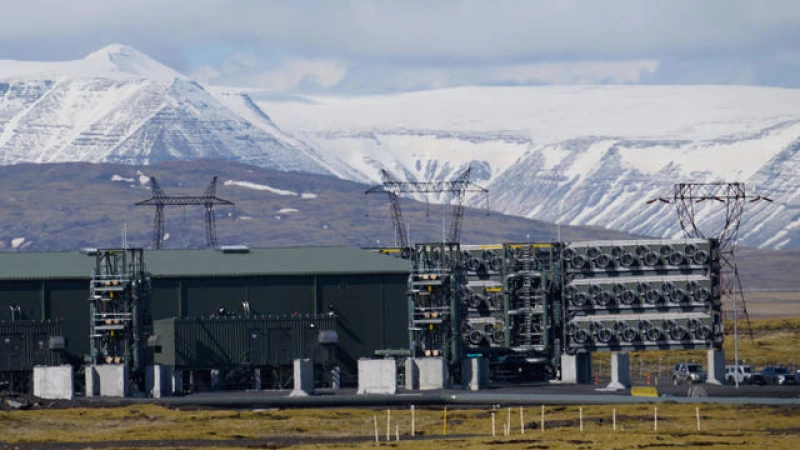Hellisheidi, Iceland — With Mammoth's 72 industrial fans, Swiss start-up Climeworks intends to suck almost 40,000 tons of CO2 from the air annually to bury underground, vying to prove the technology has a place in the fight against global warming. Mammoth, the largest carbon dioxide capture and storage facility of its kind, launched operations this week situated on a dormant volcano in Iceland.
The facility adds significant capacity to Climework's first project, Orca, which also sucks the primary greenhouse gas that is fueling climate change out of the atmosphere.
How does Climeworks capture CO2?
Just 31 miles from an active volcano, the seemingly risky site was chosen for its proximity to the Hellisheidi geothermal energy plant necessary to power the facility's fans and heat chemical filters to extract CO2 with water vapor.

The CO2 is then separated from the steam and compressed in a hangar where huge pipes crisscross.
Finally, the gas is dissolved in water and pumped underground with a "sort of giant SodaStream," said Bergur Sigfusson, chief system development officer for Carbfix, which developed the process.
A well, drilled under a futuristic-looking dome, injects the water 2,300 feet down into the volcanic basalt that makes up 90% of Iceland's subsoil, where it reacts with the magnesium, calcium and iron in the rock to form crystals — solid reservoirs of CO2.
There are a number of other CO2 capture technologies being put to use around the world, including in the U.S., where the Biden administration has committed nearly $4 billion to jumpstart the industry.
The methods range from warehouses full of stacked limestone blocks that absorb CO2 like sponges to burying compressed industrial and agricultural waste to lock the gas away for centuries.
Lofty carbon capture ambitions
For the world to achieve "carbon neutrality" by 2050, "we should be removing something like six to 16 billion tonnes [17.6 U.S. tons] of CO2 per year from the air," said Jan Wurzbacher, co-founder and co-chief of Climeworks, at the inauguration of the first 12 container fans at Mammoth.
"I quite strongly believe that a large share of these... need to be covered by technical solutions," he said.
"Not we alone, not as a single company. Others should do that as well," he added, setting his start-up of 520 employees the goal of surpassing millions of tons by 2030 — and approaching a billion by 2050.
During a recent interview on CBS' 60 Minutes, Climeworks' chief technology officer Carolos Haertel discussed the potential for scaling up carbon capture technology on a global scale. Haertel emphasized that while the technical aspects are feasible, it would require more than just one company's efforts. He suggested that political will and societal support are crucial for such initiatives to succeed.
"Whether we are taking the right direction will depend as much on societal things than on technical matters," Haertel told 60 Minutes' Bill Whitaker at the Orca facility. "Am I optimistic as an engineer? I am, absolutely. Am I optimistic as a citizen? Maybe half-half. I haven't made my mind up yet."
After three years of operating the Orca facility, Climeworks plans to increase its carbon capture capacity from 4,409 to 44,000 tons of CO2 annually with the launch of Mammoth. However, this amount is only a fraction of the world's total emissions.
Another company interviewed by CBS News in 2023 shared its goal of eventually capturing and storing 50,000 tons of CO2 per year as part of carbon capture initiatives.
Part of the Solution
According to the Intergovernmental Panel on Climate Change (IPCC), carbon removal technologies like direct air capture with carbon storage (DACCS) will play a crucial role in achieving the targets set by the 2015 Paris Agreement. However, the priority remains on significantly reducing emissions to combat climate change.
DACCS technology, while promising, is currently limited in climate models due to its high cost. Its widespread implementation hinges on the availability of renewable energy sources to power the carbon capture process.
Climeworks, a trailblazer in the field, has successfully transitioned from pilot projects to full-scale operations, achieving a cost of approximately $1,000 per ton captured. The company's goal is to further reduce this cost to just $300 by the year 2030.
Over 20 new infrastructure initiatives, involving a mix of direct capture and storage technologies, are slated to come online globally by 2030. These projects are expected to have a combined capacity of around 11 million tons.
Christoph Gebald, co-founder and co-CEO of Climeworks, stated that an estimated $10 billion will be required over the next decade to expand operations in countries like the United States, Canada, Norway, Oman, and Kenya. This amount is significantly higher than the funds the company has raised thus far.
"When I'm standing now at Orca I think: 'Oh this looks like a little bit like Lego bricks'. It's a tiny thing compared to Mammoth," remarked Wurzbacher, highlighting the innovative design of their carbon capture infrastructure.
Notably, Lego has purchased carbon credits from Climeworks for each ton of CO2 stored, a move aimed at raising awareness about carbon capture solutions. Gebald also mentioned the possibility of selling credits to larger polluting entities in the future.
While some critics raise concerns about the potential drawbacks of carbon capture technology, such as enabling continued pollution or diverting funds from other sustainable technologies, proponents argue that it is a crucial tool in combating climate change.







